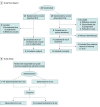Efficacy of Systemic Chemotherapy in Patients With Low-grade Mucinous Appendiceal Adenocarcinoma: A Randomized Crossover Trial
- PMID: 37261831
- PMCID: PMC10236240
- DOI: 10.1001/jamanetworkopen.2023.16161
Efficacy of Systemic Chemotherapy in Patients With Low-grade Mucinous Appendiceal Adenocarcinoma: A Randomized Crossover Trial
Abstract
Importance: Appendiceal adenocarcinoma is a rare tumor, and given the inherent difficulties in performing prospective trials in such a rare disease, there are currently minimal high-quality data to guide treatment decisions, highlighting the need for more preclinical and clinical investigation for this disease.
Objective: To prospectively evaluate the effectiveness of fluoropyrimidine-based systemic chemotherapy in patients with inoperable low-grade mucinous appendiceal adenocarcinoma.
Design, setting, and participants: This open-label randomized crossover trial recruited patients at a single tertiary care comprehensive cancer center from September 2013 to January 2021. The data collection cutoff was May 2022. Enrollment of up to 30 patients was planned. Eligible patients had histological evidence of a metastatic low-grade mucinous appendiceal adenocarcinoma, with radiographic imaging demonstrating the presence of mucinous peritoneal carcinomatosis and were not considered candidates for complete cytoreductive surgery. Key exclusion criteria were concurrent or recent investigational therapy, evidence of bowel obstruction, and use of total parenteral nutrition. Data were analyzed from November 2021 to May 2022.
Interventions: Patients were randomized to either 6 months observation followed by 6 months of chemotherapy, or initial chemotherapy followed by observation.
Main outcomes and measures: The primary end point was the percentage difference in tumor growth in treatment and observation groups. Key secondary end points included patient-reported outcomes in the chemotherapy and observation periods, objective response rate, rate of bowel complications, and differences in overall survival (OS).
Results: A total of 24 patients were enrolled, with median (range) age of 63 (38 to 82) years, and equal proportion of men and women (eg, 12 men [50%]); all patients had ECOG performance status of 0 or 1. A total of 11 patients were randomized to receive chemotherapy first, and 13 patients were randomized to receive observation first. Most patients (15 patients [63%]) were treated with either fluorouracil or capecitabine as single agent; 3 patients (13%) received doublet chemotherapy (leucovorin calcium [folinic acid], fluorouracil, and oxaliplatin or folinic acid, fluorouracil, and irinotecan hydrochloride), and bevacizumab was added to cytotoxic chemotherapy for 5 patients (21%). Fifteen patients were available to evaluate the primary end point of difference in tumor growth during treatment and observation periods. Tumor growth while receiving chemotherapy increased 8.4% (95% CI, 1.5% to 15.3%) from baseline but was not significantly different than tumor growth during observation (4.0%; 95% CI, -0.1% to 8.0%; P = .26). Of 18 patients who received any chemotherapy, none had an objective response (14 patients [77.8%] had stable disease; 4 patients [22.2%] had progressive disease). Median (range) OS was 53.2 (8.1 to 95.5) months, and there was no significant difference in OS between the observation-first group (76.0 [8.6 to 95.5] months) and the treatment-first group (53.2 [8.1 to 64.1] months; hazard ratio, 0.64; 95% CI, 0.16-2.55; P = .48). Patient-reported quality-of-life metrics identified that during treatment, patients experienced significantly worse fatigue (mean [SD] score, 18.5 [18.6] vs 28.9 [21.3]; P = .02), peripheral neuropathy (mean [SD] score, 6.67 [12.28] vs 38.89 [34.88]; P = .01), and financial difficulty (mean [SD] score, 8.9 [15.2] vs 28.9 [33.0]; P = .001) compared with during observation.
Conclusions and relevance: In this prospective randomized crossover trial of systemic chemotherapy in patients with low-grade mucinous appendiceal adenocarcinoma, patients did not derive clinical benefit from fluorouracil-based chemotherapy, given there were no objective responses, no difference in OS when treatment was delayed 6 months, and no difference in the rate of tumor growth while receiving chemotherapy.
Trial registration: ClinicalTrials.gov Identifier: NCT01946854.
Conflict of interest statement
Figures






